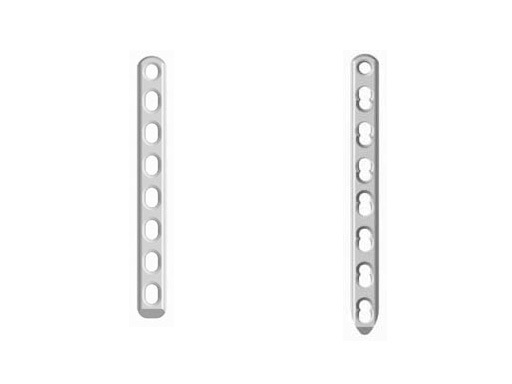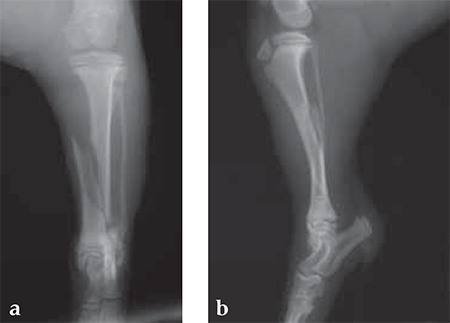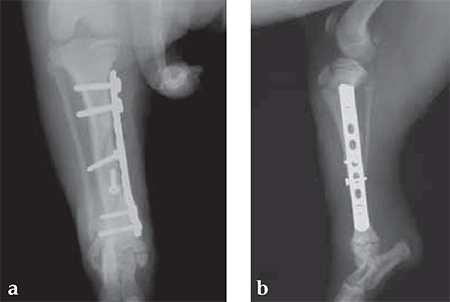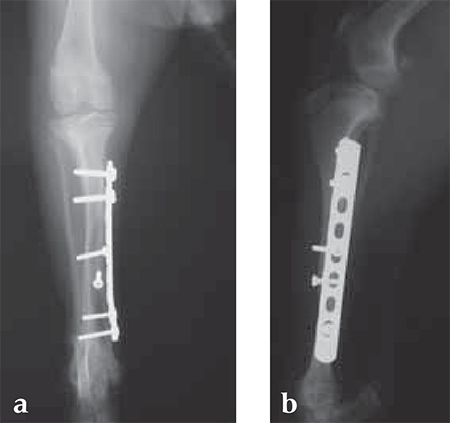
Mini LC -DCP and LCP
The Mini LC-DCPs and LCPs are designed for long-bone fractures in small breed dogs and cats.
The mini LC-DCPs and LCPs utilize the standard LC-DCP and locked plate design with a few minor changes. The plates feature the standard toe nail design for MIPO at one end of the plate.
The outermost hole opposite to the toe nail plate extremity was changed from either a combination hole to a stacked combination hole (Mini LCP) or from a DCU hole to a round hole. This design change allows for placement of the plate as close to the joint as possible, similar to the 3.5 mm LCPs for veterinary indications. These iterations facilitate minimally invasive plate placement as well as treatment of metaphyseal fractures. Additionally, the plates are thicker and stronger to withstand the greater loads seen in comminuted fractures in noncompliant animal patients. The plates retain the characteristic grooved undersurface for limited contact and more uniform stiffness.
Both Mini LC-DCP and LCP come in several versions that include:
- 2.0 mm/1.5 mm with 47 holes (1.2 mm thick)
- 2.0 mm/1.5 mm with 610, 12, 14 holes (1.5 mm thick)
- 2.4 mm with 48 holes (1.7 mm thick)
- 2.4 mm with 810, 12, 14 holes (2.0 mm thick)
- 2.7 mm with 412, 14, 16 holes (2.6 mm thick)
Both Mini LC-DCP and LCP are made of 316L stainless steel. The 2.7 mm plates fit in the vet small fragment plate set graphic case, the 2.0 mm and 2.4 mm plates fit in the vet mini fragment plate set module.
A 12-week-old Yorkshire Terrier, 1.3 kg
(Case provided by Alessandro Piras, Banbridge, Northern Ireland)
Small Bones, Small Plates: Clinical Application of Mini LCP
Hazards and labeling
Due to varying countries’ legal and regulatory approval requirements, consult the appropriate local product labeling for approved intended use of the products described on this website. All devices on this website are approved by the AO Technical Commission. For logistical reasons, these devices may not be available in all countries worldwide at the date of publication.
Legal restrictions
This work was produced by AO Foundation, Switzerland. All rights reserved by AO Foundation. This publication, including all parts thereof, is legally protected by copyright.
Any use, exploitation or commercialization outside the narrow limits set forth by copyright legislation and the restrictions on use laid out below, without the publisher‘s consent, is illegal and liable to prosecution. This applies in particular to photostat reproduction, copying, scanning or duplication of any kind, translation, preparation of microfilms, electronic data processing, and storage such as making this publication available on Intranet or Internet.
Some of the products, names, instruments, treatments, logos, designs, etc referred to in this publication are also protected by patents, trademarks or by other intellectual property protection laws (eg, “AO” and the AO logo are subject to trademark applications/registrations) even though specific reference to this fact is not always made in the text. Therefore, the appearance of a name, instrument, etc without designation as proprietary is not to be construed as a representation by the publisher that it is in the public domain.
Restrictions on use: The rightful owner of an authorized copy of this work may use it for educational and research purposes only. Single images or illustrations may be copied for research or educational purposes only. The images or illustrations may not be altered in any way and need to carry the following statement of origin “Copyright by AO Foundation, Switzerland”.
Check www.aofoundation.org/disclaimer for more information.
If you have any comments or questions on the articles or the new devices, please do not hesitate to contact us.
“approved by AO Technical Commission” and “approved by AO”
The brands and labels “approved by AO Technical Commission” and “approved by AO”, particularly "AO" and the AO logo, are AO Foundation's intellectual property and subject to trademark applications and registrations, respectively. The use of these brands and labels is regulated by licensing agreements between AO Foundation and the producers of innovation products obliged to use such labels to declare the products as AO Technical Commission or AO Foundation approved solutions. Any unauthorized or inadequate use of these trademarks may be subject to legal action.
AO ITC Innovations Magazine
Find all issues of the AO ITC Innovations Magazine for download here.
Innovation Awards
Recognizing outstanding achievements in development and fostering excellence in surgical innovation.









